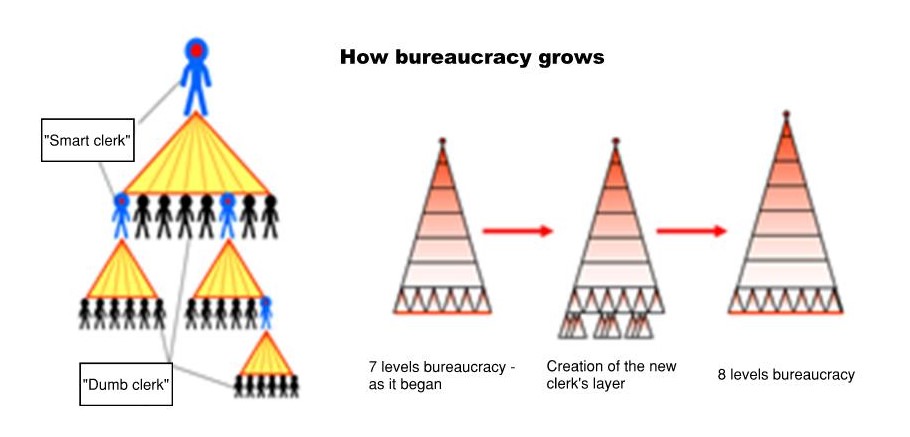Social Parkinson’s Disease
In 1998, a prestigious hospital purchased our software Innovation WorkBench® for solving inventive problems. They also requested a three-day workshop with the use of “computerized TRIZ[1]“ to obtain solutions to several problems in the process of training. During the first two days, we facilitated the trainees with solving three problems that were quite important for the audience, mostly related to using medical equipment. In the morning of the last day, Big Boss came to our class and told us that what we were doing was nonsense and that he had a Real Problem for us!
At the time of the workshop, this hospital has been about 30 years in business. During this period, they built several new buildings and nearly doubled their medical services. At the same time, the number of accountants, the invoicing time, and the amount of calculation errors quadrupled and kept growing. The number of medical errors was also rising, although a bit slower. Nobody understood why all this happened and how to stop this ugly trend.
We started working on this problem by applying the method of problem inversion as described in the first article. Instead of asking “why is this happening?” we asked an inverted question:
- If we wanted to deliberately achieve this result, what would we do?
And quite quickly got simple answers:
- Interfere as much as possible with the work process of just about everybody – doctors, nurses, accountants, managers, even janitors.
- Doctors, accountants, and all other employees should impede their own and each other’s work.
- There should also be organizers and coordinators of this “saboteur conspiracy.”
- The hospital administrators should manage the sabotage process.
- Administrators should be coerced into doing this by some high up executive.
At some point, it seemed that we would be thrown out of the hospital... But the last question prevented the disaster:
- Who and how turns honest professionals into saboteurs?
The answer to this wasn’t difficult either. All these years, at the request of the government, trade-unions, and various social organizations, strict control was imposed on physicians and nurses, on using prescriptions and medical procedures, on accounting and invoicing, etc. The final word in treatments was delegated to medical administrators who often didn't even have a medical background.
The free run of bureaucrats constantly and incompetently interfering with everything always leads to catastrophic results. Doctors and nurses don’t have time to take good care of work with patients busy with filling out forms. The number of errors in just about any decision keeps growing. The efforts to eliminate errors only lead to more paperwork, turning it into absurdity. For example, they introduced special standard codes to indicate the reason a patient was seeking medical help. The attempts to cover all possible cases resulted in a huge list that included even a code for getting bitten by a wild goose.
Unimaginable amounts of papers travel from desk to desk, getting often misplaced, lost, or incorrectly filled out. Some time back, 3-4 signatures were sufficient to issue an invoice, which took a couple of weeks. Now depending on the case, they need 12 to 15 signatures, and the process could take up to 3 months.[2]…
To our great surprise, the hospital did not turn into a “bureaucratic black hole” that mutilated and killed patients like in some third world countries or American government-managed veteran hospitals. We truly admired the people who, despite the bureaucrats, still managed to treat the patients, although likely not as good as they could have.
The obvious solution to all the problems seemed to return to the status of “30 years ago,” but who would allow it? The times were quite different back then. The presidency of Bill Clinton featured an incredible spike of bureaucracy in all life domains. So, next level solution was needed. We continued the analysis, and our group found several decent “local” solutions for speeding up the invoicing process. And apparently some of them, the least harmful for bureaucrats, have been implemented.
Severe Diagnosis
- Parkinson’s Disease is a long-term degenerative disorder that typically occurs in people of old age (Wikipedia).
- Social Parkinson’s Disease is a long-term degenerative disorder that typically occurs in aging bureaucracies (authors’ definition).
Bureaucracy as a protozoa colony
For several years, the English sociologist and historian Cyril Northcote Parkinson tried to publish the sensational results of his research, but none of the scientific magazines would accept them. He was able to publish them in 1955 as a humorous story in the British journal “The Economist,” followed by the release of the book.[3]. Parkinson conducted statistical studies on the development of bureaucracy in the English fleet, the Parliament, and several companies, where he was able to convincingly demonstrate the following:
- The growth rate of the number of bureaucrats exceeds the growth rate for the general population.
- Any bureaucracy behaves like a bacteria colony – it always seeks for expansion and grows by 5-7% each year, regardless of the required workload.
- The bureaucrats always expand their job in such a way that they use all allotted time for its completion, spend all allocated funds, and ask for more.
- Attempting to cut or at least limit the growth of the bureaucracy results in its accelerated reproduction and aggressive attacks on those who try to restrain it.
Parkinson published several more books on the subject of bureaucracy development, the last one in 1970, and then retired from scientific work. He could not explain the mechanism of the phenomenon he discovered, but his books nonetheless broke all records of citation in sociologic and economic literature for many years to come.
A puzzle for readers. Contrary to scientific norms, Parkinson got no successors – no undergraduate, graduate or Ph.D. students, professors, scientists, etc. His research on bureaucracy expansion is basically forgotten today. Why? Who could suppress the development in such an important field of science?
Sabotage of society’s service
In the 1990’s we got acquainted with Parkinson’s work and decided to implement our method of solving scientific problems to reveal the specific mechanism of bureaucracy growth.
The power that bureaucrats possess and the resulting benefits grow as they climb the hierarchy. There are two obvious methods to progress:
- Wait until the immediate superior leaves (by promotion or otherwise) and take that place. However, this method is very unreliable, as the superior could stay for decades, while there are other candidates for this position.
- Prove, one way or another, that you are the best and deserve to occupy a higher position In other words, join the battle with other candidates or even with the immediate boss. The chance of a victory is miniscule, while a punishment is a more probable outcome.
But there is another method to advance, not as obvious, safe and flawless, which does not require to lock horns with colleagues or superiors – build a whole new bureaucratic level under. It is implemented using a delicate and unpunishable technique of bureaucratic sabotage, or “work-to-rule.”
A dumb (from the bureaucracy’s viewpoint) or just honest clerk does his/her work efficiently – serving customers, making decisions within responsibilities, for example, gives or denies certain information or permission. However, a “smart clerk” works not for the customer, but for his/her own personal promotion. Instead of just doing the job (for example, tell the customer “Yes” or “No”), he raises the issue to a principal level – writes office memos and reports, calls meetings that involve people totally unrelated to the issue, organizes groups on reviewing the issue, etc. Naturally, this complicates the issue, generates a lot of commotion, and produces tons of incoming and outgoing paperwork. Eventually it turns out that the “smarty” is overloaded with work and needs an assistant, preferably more than one. And the more people, the more work is generated for them...

Soon enough, the smart clerk becomes the group leader; his superior becomes supervisor, the former supervisor turns into manager, etc. But the smart clerk is not alone, and the activity of these “smarties” results in the gradual appearance of another level of lower hierarchy – and everyone’s happy! But this is only the beginning of the story!

The fattening bureaucracy
In theory (described by future President Wilson, Weber, Durkheim, and others) and in reality, during the early stages of its development, bureaucracy had a rather strict pyramidic hierarchy, where the number of levels was determined by how many people (on average) were subordinated to one superior. This number usually ranges from 3 to 10, and the higher the number, the softer is the control system, and the more initiative it allows to subordinate.
But every growing bureaucrat strives to increase the number of subordinates, as well as the significance, size, spendings of whatever he/she is in charge of, and the amount of money or other goods that flow through his/her area of control. This leads to a growth chain reaction – the larger the bureaucracy becomes, the stronger it strives for expansion.
The bureaucracies that are created for fulfilling certain useful functions immediately start “sprouting” lots of additional and auxiliary departments not directly related to these functions. We see the thriving of all sorts of departments for human resources, providing security, censorship, political correctness and identities, managing producers, documentation, environment protection, and others that could theoretically be useful but practically are mostly harmful. They interfere with the basic functions, while creating lots of problems for the public.
Each of these auxiliary departments sort of “hanging” on the general hierarchy, thus turning the pyramid into something shapeless resembling an ugly balloon.
At the same time, the functions of workers in various departments are so entangled that any attempt to lay off someone or close a department leads to unexpected and sometimes unexplainable undesirable effects. Attempts to cancel any bureaucratic paperwork, provisions, or guidelines bring the same kind of uncertainty. A bureaucracy created for any specific task is almost impossible to “close” after the task has been completed[4], as it strives to continue living just as any living creature does.
A bureaucracy feels uncomfortable under the conditions of hard work and the need to take responsibility for its decisions. It prefers to focus on distributing wealth rather than creating it , especially if it is the money taken away from private business (the middle class). A bureaucrat’s ideal picture is when production keeps flowing by itself, while they distribute its results “on equity basis,” i.e., all the best first for themself and their “accomplices”, then for the “appropriate people.” This is why the most attractive bureaucratic positions are in supply agencies with the opportunity for unlimited cheating, in intelligence and surveillance where the bureaucrats are protected by secrecy, and in ideological committees, such as leaderships of parties or various social organizations where it becomes possible to trade information and dominance.
The bureaucracy “fattens” very fast; however, there are not enough “tasty positions” for everyone, which results in penetration of incompetent superiors into areas that require certain competence. Now the situation becomes catastrophic – the orders that they give and the rules that they impose start to cause real harm. However, “fattening” is only an intermediate stage of bureaucracy evolution. It gets worse.
[1] TRIZ is the Theory of Inventing Problem Solving - methodology developed by the genius scientist, inventor, and writer Genrich S. Altshuller. And we, Boris Zlotin and Alla Zusman, were his students, co-authors, and friends.
[2] About 24 years passed since then. We wonder, what's the situation today?
[3] Parkinson's Law: The Pursuit of Progress; London, 1958.
[4] It seems that only Donald Trump was able to find a brilliant inventive solution that allowed to almost painlessly cancel tons of bureaucratic paperwork and efficiently cut the bureaucracy! But we will talk about it later.
- Войдите или зарегистрируйтесь, чтобы оставлять комментарии
- 20 просмотров







